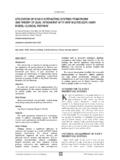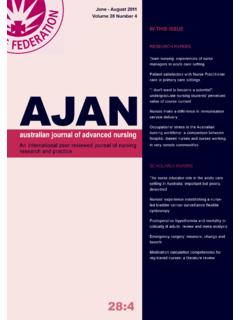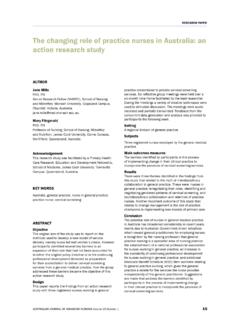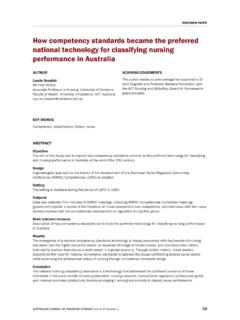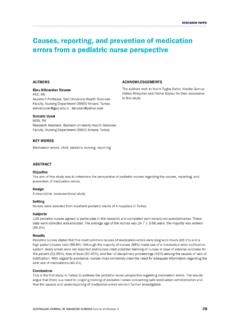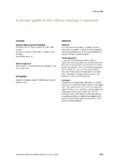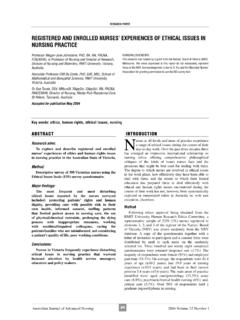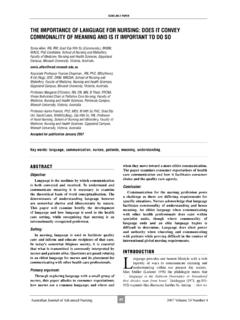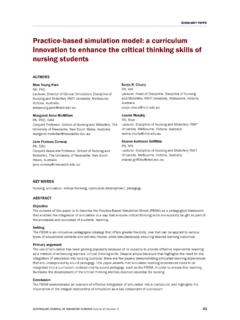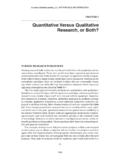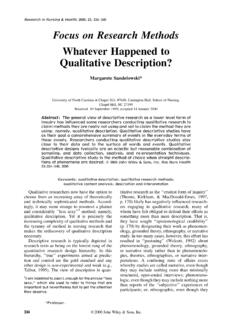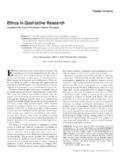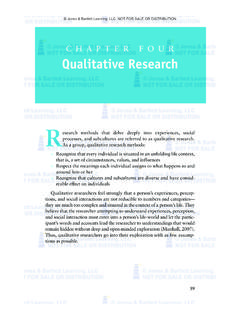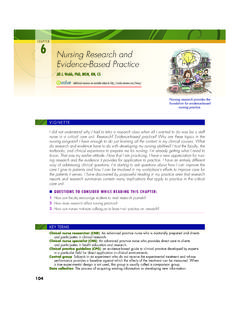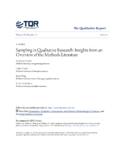Transcription of AUTHOR KEY WORDS - Australian Journal of …
1 Australian Journal OF ADVANCED nursing Volume 32 Number 334 SCHOLARLY PAPERA nurses guide to qualitative research AUTHORR ebecca (Becky) Ingham-Broomfield RN (NSW), CertEd, DipNurs (London), BSc (Hons), MSc (Health Psychology) University of New England, Armidale, NSW, Australia. WORDSR esearch methodology, qualitative research , evidence based practice (EBP).ABSTRACTO bjectiveThis article provides a breakdown of the components of qualitative research methodology. Its intention is to simplify the terminology and process of qualitative research to enable novice readers of research to better understand the concepts involved (Benner 1984).Primary ArgumentCurrent Competency Standards for Australian Registered Nurses and Midwives include a requirement to evaluate and implement research as part of their care (Borbasi and Jackson 2012, ; nursing and Midwifery Board of Australia 2012).
2 They are also expected to be actively involved in research studies (Borbasi and Jackson 2012, ). Evidence, when available, can enhance clinical judgement (Hamer and Collinson 2014, ). As evidence and research are threaded through professional work and study in the health sciences (Wright St Clair et al 2014, ) nurses, particularly novice nurses, may benefit from a discussion that helps them understand the sequence of a research paper (Moxham 2012) using qualitative systematic and logical approach will be used to discuss the content of a typical qualitative research paper. A comparative grid at the end of this paper (appendix 1) comparing the qualitative research designs, may lead the nurse to better understand the differing components of several qualitative research methods (Ingham-Broomfield 2014). Australian Journal OF ADVANCED nursing Volume 32 Number 335 SCHOLARLY PAPERINTRODUCTIONAn expectation of nurses graduating is that they will become critical consumers of research (Wright St Clair et al 2014).
3 Liamputtong (2013, p. 5) and Wright St Clair et al (2014, 5) agree Evidence Based Practice (EBP) can be defined as the conscientious integration of best research evidence with clinical expertise, patient values and needs in the delivery of high quality, cost effective health care. Assessment tools are used on a regular basis by clinicians in clinical practice, and during research (Imms and Greaves 2013) to ultimately improve patient care. In this paper main components of qualitative research will be discussed as one paradigm for researching health related problems and issues. THE qualitative research PAPERD efinition and meaning of qualitative research : qualitative research is used to examine subjective human experience by using non statistical methods of analysis (Borbasi and Jackson 2012). It is associated with naturalistic inquiry which explores the complex experience of human beings (Moxham 2012, ).
4 qualitative research is underpinned by several theoretical perspectives namely Constructivist Interpretive, Critical, Post positivist, Post structural/Postmodern and Feminism or by its research design, Phenomenology, Ethnography, Grounded Theory (Glaser and Strauss 1967) Historical method and Case study (Borbasi and Jackson 2012, ). The definitions will be explored in more depth as this paper unfolds. The paper also acknowledges that not all forms of qualitative research can be discussed due to the word research explores a subjective, holistic pathway which helps to develop theory (Burns and Grove 2009). Whereas quantitative research is based on scientific method, qualitative research suits behavioural and social sciences as it aids in understanding the unique nature of human beings (Burns and Grove 2009). qualitative research can generate information that can help nurses by informing clinical decisions.
5 qualitative nursing research focuses on patients and/or health professionals experiences. Through this approach the reality of people s experiences and lives are not over simplified and subsumed into a number or a statistic (Hoffmann et al 2013, ).Abstract/SummaryAn abstract or summary of a qualitative paper is a brief objective summary of the research report, in fact, the language and material is often pared back to the bare minimum (Polit and Hungler 2013, ; Borbasi and Jackson 2012, ; Nieswiadomy 2012). It must contain information on the rationale and background of the study as well as the theoretical and methodological processes for gathering the information (Borbasi and Jackson 2012). This will include the method to collect data, the results, conclusion and recommendations. The qualitative abstract is more narrative in form and less likely to use the obscure research and specialty clinical language of quantitative research (Borbasi and Jackson 2012, ).
6 Identifying the problemQualitative designs do not use hypotheses. They may state an observational question to be explored. Ideally the topic is narrowed down to a specific one sentence statement of the problem (Nieswiadomy 2012). qualitative research views reality as a subjective and multi faceted experience using questions more closely tied to the human experience such as What is it like to be lonely? (Borbasi and Jackson 2012, ) or, even more generally, How do you feel? (Hoffmann et al 2013, )Literature SearchThe literature review is generally in the introductory section (Polit and Hungler 2013). The function of a literature search in qualitative research varies depending on the classification of the study. A Phenomenological Australian Journal OF ADVANCED nursing Volume 32 Number 336 SCHOLARLY PAPER investigator may conduct a search to ascertain whether a subject area, such as lived experience, has been researched, as well as identify other ideas in design and conduct (Borbasi and Jackson 2012, ).
7 In Historical research the literature search is an essential and integral component which may be an extensive undertaking to narrow the event from overwhelming proportions to a more manageable time frame (Borbasi and Jackson 2012, ). Alternately, a Grounded Theory investigator may make a point of avoiding the literature before beginning the study to avoid contamination of the data with preconceived concepts and notions about what might be relevant (Borbasi and Jackson 2012, ). The Critical Theorist, who attempts to confront social injustices, will, by the nature of their research , need to conduct a literature review as previous events such as socio political ideologies, shape their and Inductive ReasoningDeductive reasoning is also known as top down approach where the investigator works from more general information to something more specific. The investigator uses a logical statement, a hypothesis, to test a theory (Jirojwong et al 2011; Burns and Grove 2009).
8 This is used in quantitative methodology. Inductive reasoning, also known as bottom up , works the opposite way, moving from the specific to the general, ending up with general conclusions or theories (Jirojwong et al 2011; Burns and Grove 2009). This is the basis of qualitative PerspectivesA theoretical perspective is based on the underlying beliefs that helped inform the research . Put simply, a theory is a perspective, or point of view, also known as a paradigm. qualitative research is underpinned by several theoretical perspectives, or paradigms, namely, Constructivist Interpretive, Critical, Post positivist, Post structural/Postmodern and Feminist (Liamputtong 2013; Borbasi and Jackson 2012; Jirojwong et al 2011). Constructivist Interpretive approaches have the intention of understanding the human world of experience relying on the participants view of the situation being studied using an interpretive understanding called hermeneutics (Liamputtong 2013, ).
9 It helps explore practical concerns of everyday living, examining the way people develop interpretations of their life, in relation to their experiences (Liamputtong 2013, ). Critical theorists are agents of change who are interested in the social construction of experience, particularly inequality and social injustice, who develop knowledge to help create positive and empowering change (Borbasi and Jackson 2012, ; Jirojwong et al 2011). The Post positivist perspective grew out of disenchantment with the radical objectivity of the quantitative research style. The Post positivist style, which is interpretive, seeks to understand people through lived experiences (Borbasi and Jackson 2012). Post structural, or postmodern studies, are concerned with the everyday life with concepts such as culture, gender, power and oppression (Borbasi and Jackson 2012). Feminism is concerned with women s issues recognising women s experiences, beliefs, views, ways of being and ways of knowing as legitimate and authoritative sources of knowledge as well as raising awareness of gender inequality and oppression (Jirojwong et al 2011, ).
10 DesignsQualitative research falls in to five main designs, namely, Phenomenology, Ethnography, Grounded Theory (Glaser and Strauss 1967), Historical method and Case study (Borbasi and Jackson 2012; Burns and Grove 2009). Phenomenology searches for multiple meanings attributed to a phenomenon and tries to provide a comprehensive description rather than an explanation (Liamputtong 2013, ). It is used to describe the everyday world of human experience (Jirojwong et al 2011, ). Ethnography has its origins in anthropology with its focus on the study of humans from the evolutionary and social perspectives (Jirojwong et al 2011, ) and focuses on the scientific study of the lived culture of a group of people (Liamputtong 2013, Australian Journal OF ADVANCED nursing Volume 32 Number 337 SCHOLARLY ). Grounded theory is a systematic form of enquiry which generates social theory through the study of social systems present in human interaction (Jirojwong et al 2011, ).
